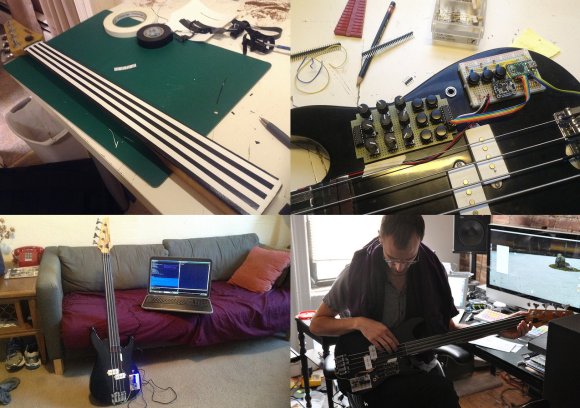
[Brendan Byrne] stripped this instrument down to basics and built himself a ribbon controller bass guitar. Details are still a bit sparse on his website, but there are plenty of detailed pictures on his flickr stream. [Brendan] built his bass as part the Future of Guitar Design Course at Parsons the New School for Design. His goal was to create an experience in which playing the instrument and altering parameters of effects are triggered by the same gestures. He’s definitely succeeded in that effort.
Basically, the bass is a four channel ribbon controller. The frets were removed to make way for four graphite strips. [Brendan] followed [Iain’s] excellent tutorial to create his own graphite strips using soft artist’s pencils. The ribbons essentially become potentiometers, which are then read by a teensy. [Brendan] expanded the instrument’s sonic palette by adding several buttons and potentiometers mapped to MIDI control codes. He even included a triple axis accelerometer so every movement of the bass can be mapped. The MIDI data is sent to a PC running commercial music software. Analog sound comes from a piezo pickup placed under the bridge of the bass.
The results are pretty awesome. While we can’t say [Brendan’s] demo was music to our ears, we definitely see the musical possibilities of this kind of instrument.
https://www.youtube.com/watch?v=tJALDEuah-A
[Thanks JohnS_AZ!]















Are there any videos of music actually being played?
LOL Rusty. That’s what I was thinking. Of course, I can’t claim to pick up a Violin and immediately sound good…
That’s assuming that musical talent is being applied. the electronics is there but it’s one step above circuit bending. The refinement required to hit the right resistance level is an order of magnitude above that which a trombone player uses. it just sounded like noise to me. I would love to hear what someone could do with this after several years of practice tho. it is a good hack
I hacked together something similar with VHS tape connected with 2sided scotch tape and a wire stretched over top of it mounted on a board. By pressing the wire down onto the tape it completed the pitch control of an analog square wave oscillator. Resistance came from the length of tape between the bridge and the finger position. By adjusting the cap value of the oscillators RC circuit with the resistance range of the tape section I could get a good range of notes. I might have to pull it back out and tinker some more.
As a bass player I don’t get what he’s going for here. If it’s an attempt to hack a musical instrument into a varmint repellant it looks like a winner.
I was hoping to hear something more like this: http://youtu.be/_kDhpFaf4EY?t=2m21s
I initially thought it was an attempt to be able to sense the position of fingers, strum rate, slides, etc… but I am scratching my head also.
Yeah I thought it could be used to automate tone changes based on where he’s at in the song. Some day I’d like to add a DSP to a guitar to emulate a variety of effects pedals on-board and I’ll need a good way to change tones without taking my hands off the the strings. Maybe this could accomplish that.
But my opinion is a bass is best left alone. I like clean tones or a little bit of compression but beyond that I feel effects just detract from the sound.
The bass guitar is just an interface, the MIDI controller is the instrument. Missing the forest for the trees, a little bit.
Apparently it only has one level of annoying, and that’s set to 11. They had the analog version of that “instrument” in the middle-ages, it was called “bag-o-cats”.
Usually a bass doesn’t sound like that unless you drop it.
For some reason, It made me want to hear a cover of In-A-Gadda-Da-Vida played with fingernails on a blackboard, but it seems to be the one thing someone hasn’t put on youtube.
If anybody finds/makes one, let me know.